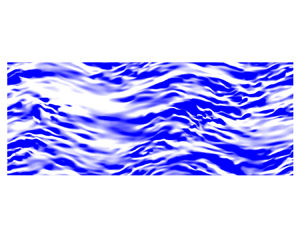Article contents
Turbulence suppression by streamwise-varying wall rotation in pipe flow
Published online by Cambridge University Press: 08 November 2022
Abstract

Direct numerical simulations of turbulent pipe flow subjected to streamwise-varying wall rotation are performed. This control method is able to achieve drag reduction and even relaminarize the flow under certain control parameters at friction Reynolds number  $Re_\tau =180$. Two control parameters, which are velocity amplitude and wavelength, are considered. It is found that increasing the wavelength rather than increasing the amplitude seems to be a better choice to improve the control efficiency. An annular boundary layer, called the spatial Stokes layer (SSL), is formed by the wall rotation. Based on the thickness of the SSL, two types of drag-reduction scenarios can be identified roughly. When the thickness is low, the SSL acts as a spacer layer, inhibiting the formation of streamwise vortices and thereby reducing the shear stress. The flow structures outside the SSL are stretched in the streamwise direction due to the increased velocity gradient. Within the SSL, the turbulence intensity diminishes dramatically. When the thickness is large, a streamwise wavy pattern of near-wall streaks is formed. The streak orientation is dominated by the mean shear-strain vector outside the viscous sublayer, and there is a phase difference between the streak orientation and local mean velocity vector. The streamwise scales of near-wall flow structures are reduced significantly, resulting in the disruption of downstream development of flow structures and hence leading to the drag reduction. Furthermore, it is found that it requires both large enough thickness of the SSL and velocity amplitude to relaminarize the turbulence. The relaminarization mechanism is that the annular SSL can absorb energy continuously from wall-normal stress due to the rotational effect, thereby the turbulence self-sustaining process cannot be maintained. For the relaminarization cases, the laminar state is stable to even extremely large perturbations, which possibly makes the laminar state the only fixed point for the whole system.
$Re_\tau =180$. Two control parameters, which are velocity amplitude and wavelength, are considered. It is found that increasing the wavelength rather than increasing the amplitude seems to be a better choice to improve the control efficiency. An annular boundary layer, called the spatial Stokes layer (SSL), is formed by the wall rotation. Based on the thickness of the SSL, two types of drag-reduction scenarios can be identified roughly. When the thickness is low, the SSL acts as a spacer layer, inhibiting the formation of streamwise vortices and thereby reducing the shear stress. The flow structures outside the SSL are stretched in the streamwise direction due to the increased velocity gradient. Within the SSL, the turbulence intensity diminishes dramatically. When the thickness is large, a streamwise wavy pattern of near-wall streaks is formed. The streak orientation is dominated by the mean shear-strain vector outside the viscous sublayer, and there is a phase difference between the streak orientation and local mean velocity vector. The streamwise scales of near-wall flow structures are reduced significantly, resulting in the disruption of downstream development of flow structures and hence leading to the drag reduction. Furthermore, it is found that it requires both large enough thickness of the SSL and velocity amplitude to relaminarize the turbulence. The relaminarization mechanism is that the annular SSL can absorb energy continuously from wall-normal stress due to the rotational effect, thereby the turbulence self-sustaining process cannot be maintained. For the relaminarization cases, the laminar state is stable to even extremely large perturbations, which possibly makes the laminar state the only fixed point for the whole system.
JFM classification
- Type
- JFM Papers
- Information
- Copyright
- © The Author(s), 2022. Published by Cambridge University Press
References
REFERENCES
- 5
- Cited by



